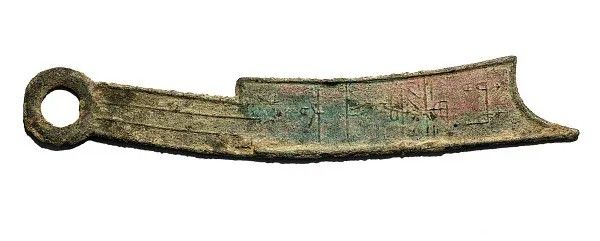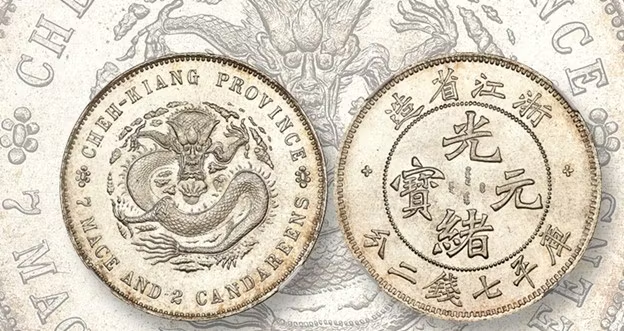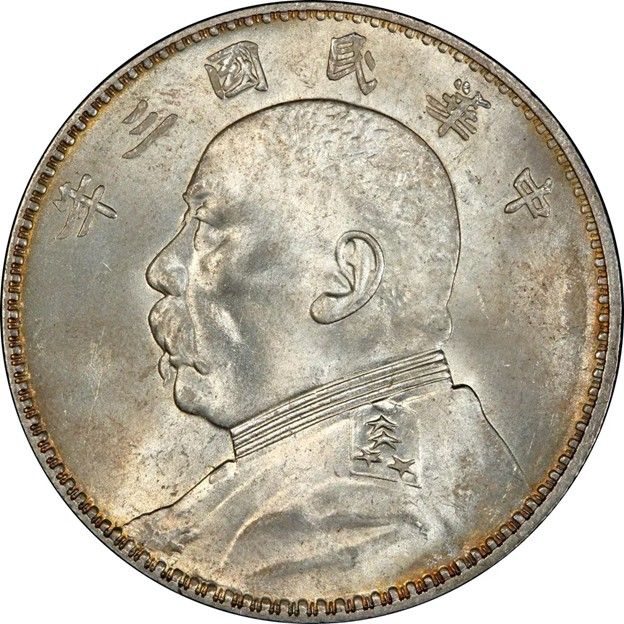Chinese Coins: From Ancient Cash to Modern Silver Pandas – Your Complete Collector’s Guide
Posted on — Leave a commentChinese coins present one of numismatics’ most rewarding categories – and one of its most challenging. Spanning more than two millennia, it ranges from cast bronze cash coins and imperial silver issues to modern Panda bullion that rivals Western standards. For collectors, this depth offers genuine opportunity but also significant obstacles: unfamiliar scripts, overlapping reign marks, and a market where counterfeits exist for virtually every major issue. This guide outlines the major eras of Chinese coinage, the factors that influence value, and practical considerations for building a serious, well-curated collection.
What Makes Chinese Coins Special
Before exploring individual eras and coin types, it helps to understand what defines Chinese coinage as a whole.
Enduring Continuity
When the Qin Dynasty unified China in 221 BC, it standardized currency into a form that would outlast the Roman Empire, the Byzantine solidus, and medieval European coinage combined. Chinese coins with a square hole in the middle became China’s monetary standard and remained essentially unchanged until the Qing Dynasty fell in 1912, a span of over two millennia. While European coinage fragmented into regional types and underwent constant reforms, Chinese cash coins preserved their design through dozens of dynastic transitions. This continuity created a visual identity that transcends individual reigns.

Image: Qing Dynasty cash coin with square hole and Chinese characters.
Source: Museums Victoria
Symbolism and Authority
Rather than portraits, Chinese coins displayed reign marks, i.e. characters proclaiming the emperor’s era name. This creates a fundamentally different collecting challenge than Western coinage. Instead of identifying rulers by profile, collectors must learn Chinese scripts and recognize calligraphic styles that varied by dynasty. Later issues added dragons, phoenixes, and clouds, connecting currency to celestial legitimacy.
Calligraphy and Craftsmanship
The inscriptions on Chinese coins weren’t struck from identical dies like Western issues. Most were cast from molds, meaning calligraphy was carved directly into the master model by hand. Each dynasty developed its own script style, and individual mints often interpreted these characters differently. A Northern Song coin might show fine, balanced strokes reminiscent of brush calligraphy, while Qing issues favor heavier, more regular forms. For collectors, this variation gives each specimen individuality.
Modern Continuity: The Panda and Beyond
Modern bullion issues like the Gold and Silver Panda series, introduced in the early 1980s, carry forward these principles in contemporary form. The changing panda designs echo the artistic individuality once expressed through calligraphy, while inscriptions in standardized Chinese script preserve the link between currency and national identity. Struck to precise international standards, Pandas merge ancient symbolism with modern minting technology – proof that Chinese coinage still balances tradition, innovation, and artistry in the global bullion market.
Complete Chinese Coin Era Breakdown
Chinese coinage is divided into ancient cast issues and modern struck coins.
Ancient Chinese Coins: Cash Coins and Imperial Issues
Origins of Chinese Money (Pre-221 BC) [H4]
Before standardized coinage, Chinese states used cowrie shells, spade money (flat bronze pieces shaped like agricultural tools), and knife money (bronze knife-shaped currency from northern regions). These early forms carried inscriptions identifying issuing authorities. Authenticating them requires examining weight consistency, natural patina, and casting quality. Reproductions typically show artificial aging and anachronistic or poorly executed inscriptions. For a visual guide to some of the most valuable early Chinese coins and their distinguishing features, watch this video.

Image: Ancient Chinese bronze knife money with inscriptions.
Source: National Museum of American History
The Qin Reform and Birth of Cash Coins (221 BC)
Emperor Qin Shi Huang standardized currency into the ban liang, i.e. a round bronze coin with a square hole, eliminating regional varieties and establishing the format that would last two thousand years.
Dynastic Evolution of Cash Coins (Han – Qing)
Cash coins maintained their basic form across dynasties but evolved in inscription style, weight, and casting quality. Most display four-character legends read top-bottom-right-left, naming the reign era and denomination. Calligraphic styles varied: Han coins show simple characters, Tang pieces display elegance, Song issues feature refined execution, and Qing coins use bolder scripts. Provincial mints created subtle variations useful for attribution. In terms of availability, late Qing and Ming issues remain common, but certain early Han types and well-preserved Song specimens command significant premiums. Condition plays a major role in valuation, with collectors prioritizing crisp characters and natural patina over worn or corroded examples.
Imperial Silver and Gold (Late Qing – 1911)
As Western powers pressured China to modernize its currency, the Qing government introduced machine-struck silver coins in 1889. These pieces were Chinese coins with dragon designs featuring bilingual Chinese and Manchu legends, created to compete with foreign trade dollars circulating in Chinese ports. Provincial mints in Guangdong, Yunnan, and Sichuan produced distinctive varieties, some exceptionally rare due to limited mintages. Chinese gold coins existed in smaller quantities, primarily for diplomatic presentation. These late imperial issues bridged traditional cast bronze and modern Western minting technology.

Image: Late Qing Dynasty silver dragon dollar from Chekiang Province.
Source: Coin World
Modern Era: Republican Chinese silver coins to Contemporary Bullion
Republican Era (1912 – 1949)
The fall of the Qing Dynasty ended imperial coinage but not silver production. The new Republic continued minting silver dollars using Western technology, introducing portraits of political leaders like Yuan Shikai and Sun Yat-sen. These coins, including the “Fat Man” dollar (Yuan Shikai) and various Sun Yat-sen types, featured Western-influenced designs with Latin legends alongside Chinese inscriptions, marking a decisive break from Chinese coins with dragon imagery. Provincial mints produced their own varieties, and certain early issues with low mintages or die variations are highly collectible today. Silver circulation declined sharply after the mid-1930s, following the U.S. Silver Purchase Act of 1934, which drained China’s silver reserves, and the outbreak of the Second Sino-Japanese War in 1937, which further disrupted production and trade.

Image: Republic of China silver dollar with Yuan Shikai portrait.
Alt text: Chinese Republic “Fat Man dollar” from 1914-1921 showing Yuan Shikai left-facing portrait with Chinese characters and reeded edge, .890 silver.
Source: Numista
People’s Republic and Early Communist Era (1949 – 1980)
After 1949, the new government replaced precious metal coins with aluminum, copper-nickel, and brass issues. Designs emphasized socialist themes, such as workers, agriculture and industrial imagery, reflecting state ideology. Chinese commemorative coins in silver and copper-nickel celebrated political milestones like founding anniversaries and often celebrated revolutionary milestones. Most early People’s Republic circulation coins carry modest collector value, significant primarily as markers of China’s transition from precious metals to symbolic state coinage.
Reform and Bullion Revival (1980s – Present)
Economic liberalization in the 1980s reopened precious metal minting. China launched its Gold and Silver Panda series in 1982 and 1983 respectively, featuring .999 fine purity and annually changing panda designs, a departure from static Western bullion. Issued in multiple weights, Pandas merged national symbolism with modern engraving techniques, continuing China’s tradition of artistic coinage. Early issues from 1983 to 1985 – and particularly small-date and proof varieties – command strong premiums due to lower mintages. Counterfeits remain a persistent problem and collectors must verify authenticity through precise weight, diameter, and edge reeding.

Image: Modern Chinese Silver Panda bullion coin with bamboo background.
Source: Blanchard
Commemorative and Thematic Programs (1990s – Present)
Beyond Pandas, China produces limited-mintage gold commemoratives for historical events and anniversaries. The Lunar series, which consists of annual gold and silver coins honoring Chinese zodiac animals, has gained international popularity for its artistry and cultural resonance. Occasional bimetallic and platinum issues diversify the modern program. Chinese modern bullion, especially Pandas and early Chinese commemorative coins, typically carries higher numismatic premiums than generic bullion due to design changes and sustained collector demand.
Starting a Chinese Coin Collection in the Modern Era
The past two decades have transformed Chinese numismatics from a niche specialty into a major collecting category recognized in global auctions and investment portfolios. For new collectors, this modern era offers unprecedented access to both ancient Chinese coins and contemporary ones. Online resources, certification services, and active global markets make it possible to build a focused collection – whether centered on ancient cash coins, imperial silver, or modern Pandas – with greater confidence and accessibility than ever before
Global Market Growth
Chinese coins, particularly Silver Pandas and Lunar series issues, have gained strong traction among Western collectors over the past two decades. Rising awareness of Chinese culture, renewed interest in precious metals, and the aesthetic appeal of annually changing designs have driven sustained demand. Major Western auction houses now feature Chinese material regularly, and specialized dealer networks have emerged to serve this growing market.
Digital Authentication and Grading Standards
Technology has significantly improved verification and grading methods. Smartphone tools assist in comparing coins to reference images, while portable XRF analyzers verify metal composition on-site. Third-party grading services such as PCGS and NGC, both operating China-specific divisions, certify Chinese coins to international standards. Encapsulated (“slabbed”) examples often command premiums over raw pieces, especially for high-value issues where counterfeiting risk is greatest.
Buying and Selling Online
Chinese coins for sale are widely available through online platforms, but caution remains essential. Reputable dealers with clear return policies and authenticity guarantees provide the safest buying environment. Major auction platforms offer access to rare Chinese coins, though seller credentials should always be verified. Direct purchases from Chinese consumer sites carry higher risk: counterfeits are prevalent and buyer recourse limited. For selling, established dealers and auctions provide liquidity.
Roll Hunting and Circulation Finds
Outside China, discovering Chinese coins in circulation is uncommon but occasionally possible in areas with large Chinese communities. Most circulation finds are base-metal issues of modest value.
Identification and Authentication Guide
Authenticating Chinese coins requires understanding both historical production methods and modern counterfeiting techniques. The prevalence of high-quality fakes makes verification skills essential for any serious collector.
Character Recognition
Learning basic Chinese numerals and common reign marks forms the foundation of identification. Most cash coins display four characters read top-bottom-right-left, typically showing the emperor’s era name followed by tongbao (circulating treasure) or zhongbao (heavy treasure). Familiarizing yourself with frequently encountered dynasties, particularly Ming and Qing, allows quick preliminary assessment. Modern coins use simplified Chinese characters and Arabic numerals for dates and denominations.
Weight Standards
Authentic coins conform to specific weight ranges for their type and era. Cash coins varied by dynasty, but consistency within a series indicates genuineness. For early bronze issues, minor variation (often a few tenths of a gram) is normal, as exact uniformity was not achieved until machine striking. Modern Pandas and commemoratives must match published specifications exactly and even slight deviations suggest counterfeits.
Metal Composition
Testing silver and gold content verifies precious metal coins. Non-destructive methods include specific gravity tests, which compare weight-to-volume ratios against known standards. XRF analyzers provide precise composition readings without damaging coins. For old Chinese coins, particularly bronze pieces, patina color and texture offer clues: genuine bronze develops characteristic blue-green or brown oxidation.
Die Characteristics
Genuine Chinese coins show detail consistent with their minting method. Cast pieces exhibit subtle casting seams and granular texture, while struck coins display sharp rims and uniform fields. Counterfeits often reveal mismatched character styles, imprecise lettering, or incorrect edge patterns. Red flags include unusually low prices, artificial toning, and soft or uneven details inconsistent with authentic production.
Investment Perspective: Chinese Coins in 2025
Chinese coins occupy a unique position in the precious metals market, merging intrinsic metal value with numismatic rarity and deep cultural symbolism.
Advantages
Cultural Appeal
A growing Chinese and international collector base drives sustained demand, particularly for Pandas and Lunar series coins whose themes resonate across cultures. This interest is rooted in long-standing cultural attitudes toward gold as a store of wealth and a symbol of prosperity – values especially strong in China and India, which together account for nearly half of global gold demand. In both societies, gold plays a central role in savings, gifting, and intergenerational transfer. These traditions help explain why Chinese coins, especially gold and silver Pandas, maintain strong premiums even when global bullion prices soften.
Silver and Gold Content
Pandas offer precious-metal security yet command premiums over generic bullion due to annual design changes and limited mintages. For collectors evaluating silver investment options that include Chinese coins alongside other bullion products, Blanchard’s investment-grade silver selection provides a range of choices suited to different portfolio strategies.
Historical Significance
Ancient Chinese coins and imperial specimens, often bronze or silver, offer tangible connections to Chinese history, attracting collectors beyond traditional bullion investors.
Artistic Merit
The artistry of Chinese coinage attracts buyers who might not otherwise collect coins, broadening the market.
Limited Production
Annual design turnover creates natural scarcity, as each year’s Panda becomes a distinct collectible once the next design releases.
Considerations
Authenticity Concerns
High-quality counterfeits require expert verification or third-party grading before purchase.
Cultural Knowledge
Understanding Chinese history enhances collecting success, making Chinese coins more demanding than Western issues.
Import/Export Regulations
For ancient Chinese coins, regulations vary by jurisdiction and can complicate international transactions, particularly for items classified as cultural property. Exporting old Chinese coins itself is generally prohibited, and buyers should verify provenance and import requirements before making cross-border purchases.
Conclusion
Chinese coinage spans over two millennia of monetary evolution, from ancient cast bronze to modern struck bullion. For Western collectors, these coins offer a compelling combination of historical depth, artistic tradition, and investment potential that few other world coin series can match. The growing accessibility of authentication services, international grading standards, and specialized dealers has made building a Chinese collection more feasible than ever. Explore Blanchard’s Chinese Mint selection to begin or expand your collection with confidence.
FAQs
1. How much are Chinese coins worth?
Chinese coins’ value ranges from a few dollars for common late Qing cash coins to substantial sums for rare imperial silver or early-date Pandas. Condition, rarity, and authenticity determine price more than age alone.
2. Why do Chinese coins have holes?
The square hole allowed coins to be strung together on cords for counting, transport, and storage, a practical solution that became a defining feature of Chinese currency for over two thousand years.
3. How to identify ancient Chinese coins?
Read the four-character inscription top-bottom-right-left to determine the reign era and denomination, then compare calligraphic style, weight, and casting characteristics against reference materials for the suspected dynasty.
4. How to spot fake Chinese coins?
Check weight precision, examine character clarity and style consistency, look for incorrect casting seams or artificial patina on ancient Chinese coins, and verify edge reeding and specifications on modern issues. When in doubt, use third-party grading services.








